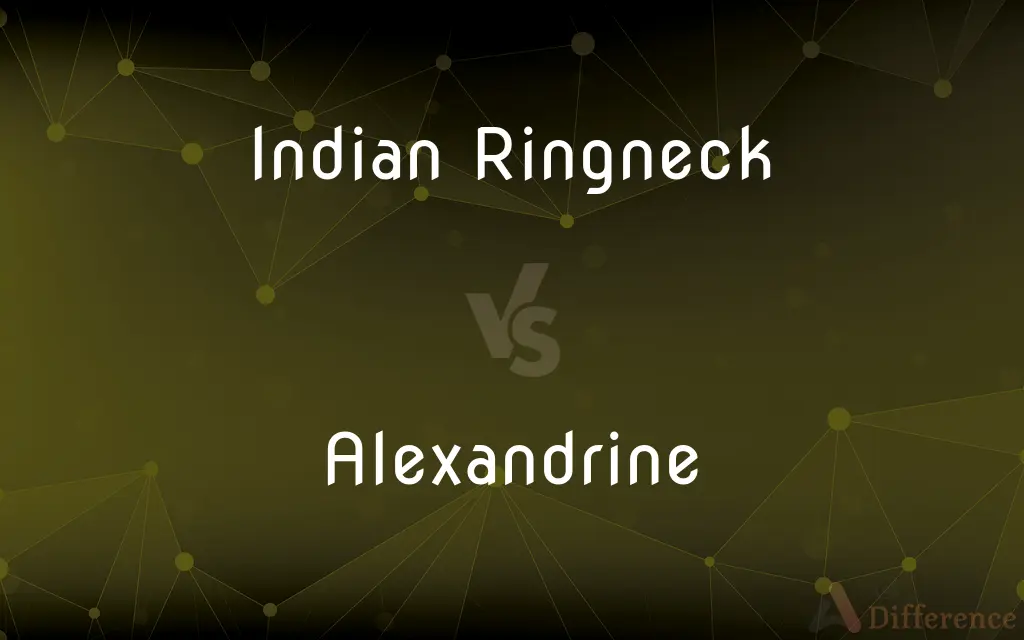Indian Ringneck vs. Alexandrine — What's the Difference?
By Tayyaba Rehman & Fiza Rafique — Published on February 28, 2024
Indian Ringnecks are smaller, vibrant parrots known for their distinctive rings, while Alexandrines are larger, with more pronounced markings and a broader color palette.

Difference Between Indian Ringneck and Alexandrine
Table of Contents
ADVERTISEMENT
Key Differences
Indian Ringnecks, often admired for their bright colors and the unique ring around their necks, are smaller parrots that excel in mimicry. They are highly sociable and can develop a vast vocabulary. In contrast, Alexandrine parakeets are larger and possess a more robust build, with a distinctive red patch on their wings and larger beaks, making them stand out in the parrot family.
Both species are known for their intelligence and ability to learn words and phrases. However, Alexandrines might require more patience during training due to their slightly more independent nature compared to the often more sociable Indian Ringnecks.
In terms of care, Indian Ringnecks might adapt more quickly to smaller living spaces and are known for their playful nature, making them suitable for families. Alexandrines, with their larger size, require more space and enrichment to keep them healthy and happy, reflecting their need for a more engaging environment.
The lifespan of an Indian Ringneck can reach up to 30 years, reflecting their long-term commitment as pets. Alexandrine parakeets, on the other hand, can live even longer, with lifespans extending up to 40 years, requiring a significant commitment from their owners.
In the wild, Indian Ringnecks are often found in forests and wooded areas in small flocks, showcasing their adaptability and social structures. Alexandrines prefer similar habitats but are often seen in larger flocks and can adapt to a wider range of forested environments, indicating a slight difference in their social and environmental preferences.
ADVERTISEMENT
Comparison Chart
Size
Smaller, up to 16 inches in length
Larger, up to 25 inches in length
Beak
Smaller and more delicate
Larger and more robust
Color
Bright green with variations, distinctive neck ring
Green with red patch on wings, more varied color palette
Lifespan
Up to 30 years
Up to 40 years
Social Behavior
Highly sociable, enjoys interaction
More independent, requires patience in training
Compare with Definitions
Indian Ringneck
A small, brightly colored parrot known for its ability to mimic speech.
The Indian Ringneck in the aviary began mimicking the zookeeper’s greetings.
Alexandrine
A large parrot with distinctive red wing patches and a robust build.
The Alexandrine’s red shoulder patches were vivid against its green feathers.
Indian Ringneck
Distinct for the ring around its neck, appearing in males.
The male Indian Ringneck displayed a black and pink ring around its neck during mating season.
Alexandrine
Prefers a diet that includes a variety of fruits, seeds, and nuts.
We supplement our Alexandrine's diet with fresh fruit to keep it healthy.
Indian Ringneck
Adaptable to various environments, both wild and domestic.
Indian Ringnecks have thrived in both their natural forest habitats and urban settings.
Alexandrine
Can be more independent, making socialization important.
Regular interaction has made our Alexandrine more sociable and less aloof.
Indian Ringneck
Requires mental stimulation and social interaction.
We keep our Indian Ringneck engaged with puzzles and daily playtime.
Alexandrine
Requires spacious living conditions due to its size.
We upgraded to a larger cage to accommodate our Alexandrine's need for space.
Indian Ringneck
Prone to developing strong bonds with their owners.
My Indian Ringneck greets me every morning with a cheerful hello.
Alexandrine
Known for its longer lifespan and size compared to other parrots.
Our Alexandrine parakeet is larger than any other bird we've owned.
Common Curiosities
Can both Indian Ringnecks and Alexandrines mimic human speech?
Yes, both are capable of mimicry, though their ability can vary individually.
What are the main differences between Indian Ringnecks and Alexandrine Parakeets?
Indian Ringnecks are smaller with a distinct neck ring, while Alexandrines are larger with red wing patches.
Which parrot has a longer lifespan?
Alexandrine Parakeets generally have a longer lifespan, up to 40 years.
Are Alexandrine Parakeets good for families?
Yes, if the family can meet their space and enrichment needs.
Are Indian Ringnecks suitable for beginners?
Yes, due to their size and sociability, but they do require dedicated attention and care.
Which parrot is more social?
Indian Ringnecks are known to be more sociable and bond closely with their owners.
How much time should I spend with my Alexandrine Parakeet daily?
Alexandrines thrive with regular, meaningful interaction, so as much time as possible.
Can Indian Ringnecks live in an apartment setting?
Yes, if they have enough space and are provided with mental stimulation.
What is the best way to train an Alexandrine Parakeet?
Patience, consistency, and positive reinforcement are key.
Do Alexandrine Parakeets require a lot of space?
Yes, their larger size means they need more space to live comfortably.
How do the diets of Indian Ringnecks and Alexandrines compare?
Both enjoy a varied diet, but Alexandrines may require more due to their size.
Do Indian Ringnecks and Alexandrines get along with other birds?
It varies by individual, but both species can coexist with others if introduced properly.
Are Indian Ringnecks noisy?
They can be, especially if they're seeking attention or bored.
What kind of toys should I get for an Indian Ringneck?
Toys that encourage foraging, problem-solving, and physical activity are ideal.
How can I tell if my Alexandrine Parakeet is healthy?
Signs of health include active behavior, a good appetite, and clean, smooth feathers.
Share Your Discovery

Previous Comparison
Linguist vs. Polyglot
Next Comparison
Plain vs. VanillaAuthor Spotlight
Written by
Tayyaba RehmanTayyaba Rehman is a distinguished writer, currently serving as a primary contributor to askdifference.com. As a researcher in semantics and etymology, Tayyaba's passion for the complexity of languages and their distinctions has found a perfect home on the platform. Tayyaba delves into the intricacies of language, distinguishing between commonly confused words and phrases, thereby providing clarity for readers worldwide.
Co-written by
Fiza RafiqueFiza Rafique is a skilled content writer at AskDifference.com, where she meticulously refines and enhances written pieces. Drawing from her vast editorial expertise, Fiza ensures clarity, accuracy, and precision in every article. Passionate about language, she continually seeks to elevate the quality of content for readers worldwide.
















































